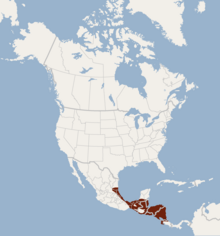| Elegant myotis | |
|---|---|
| Conservation status | |
 Least Concern (IUCN 3.1) | |
| Scientific classification | |
| Domain: | Eukaryota |
| Kingdom: | Animalia |
| Phylum: | Chordata |
| Class: | Mammalia |
| Order: | Chiroptera |
| Family: | Vespertilionidae |
| Genus: | Myotis |
| Species: | M. elegans |
| Binomial name | |
| Myotis elegans Hall, 1962 | |

| |
The elegant myotis (Myotis elegans) is a species of vesper bat found in Belize, Costa Rica, El Salvador, Guatemala, Honduras, Mexico, and Nicaragua.
Description
The elegant myotis is a small bat, with a body weight of about 4 g. Its fur is brown on the dorsal side while the ventral side is lighter and golden. Its ears are pale brown, and its flight membranes are slightly darker than its fur. The ears feature a slender and deeply notched tragus. The following body measurements are in millimeters (mm). Total body length: 76.0, length of tail: 35.0, length of hind foot: 7.0, length of ear: 12.0, tragus: 6, forearm: 34.2, and, the greatest length of skull: 13.
When compared to the California Myotis (M. californicus) and the Western small-footed bat (M. ciliolabrum), M. elegans has a shorter tail, a more pronounced golden color on its underparts, a deeper notch in their tragus, and a shorter skull. It is further differentiated from M. ciliolabrum by its paler ears, lips, and flight membranes, shorter ears, and a more slender tragus.
Like most vesper bats, M. elegans produces short duration frequency modulated (FM) echolocation calls above 50 kHz in frequency.
Biology and behavior
Little is known about the life history and behavior of the elegant bat. They are known to inhabit dry deciduous forests in El Salvador.
Based on fecal analysis, M. elegans is known to prey on insects of the Lepidoptera, Coleoptera and Diptera orders. Due to low sample size in existing studies, it is likely not a complete list of prey items for this species.
Sources
- Miller, B.; Rodriguez, B. (2016). "Myotis elegans". The IUCN Red List of Threatened Species. 2016: e.T14156A115121563. doi:10.2305/IUCN.UK.2016-3.RLTS.T14156A22057814.en.
- Hall, E. Raymond (1962). A New Bat (Myotis) From Mexico. Lawrence, Kansas: University of Kansas Publications, Museum of Natural History. pp. 161–164.
- ^ Engstrom, Mark D.; Lim, Burton K.; Reid, Fiona A. (1994). "Two Small Mammals New to the Fauna of el Salvador". The Southwestern Naturalist. 39 (3): 281–283. doi:10.2307/3671594. ISSN 0038-4909. JSTOR 3671594.
- O'Farrell, Michael J.; Miller, Bruce W. (1999). "Use of Vocal Signatures for the Inventory of Free-Flying Neotropical Bats". Biotropica. 31 (3): 507–516. doi:10.1111/j.1744-7429.1999.tb00394.x. ISSN 0006-3606. JSTOR 2663947. S2CID 84305705.
- Whitaker, John O.; Findley, James S. (1980). "Foods Eaten by Some Bats from Costa Rica and Panama". Journal of Mammalogy. 61 (3): 540–544. doi:10.2307/1379850. ISSN 0022-2372. JSTOR 1379850.
- Ingala, Melissa R.; Simmons, Nancy B.; Wultsch, Claudia; Krampis, Konstantinos; Provost, Kaiya L.; Perkins, Susan L. (2021). "Molecular diet analysis of neotropical bats based on fecal DNA metabarcoding". Ecology and Evolution. 11 (12): 7474–7491. doi:10.1002/ece3.7579. ISSN 2045-7758. PMC 8216975. PMID 34188828.
| Taxon identifiers | |
|---|---|
| Myotis elegans | |